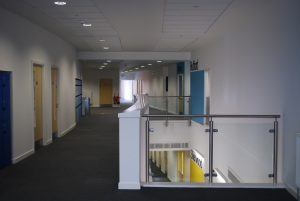
 Carrying out Fire Risk Assessments within Schools, Colleges and Universities can be difficult and complex, as many educational establishments incorporate facilities such as science blocks, food technology rooms, practical based learning (i.e. workshops) etc, all of which create a higher risk environment where there is a greater exposure to fire hazards.
Carrying out Fire Risk Assessments within Schools, Colleges and Universities can be difficult and complex, as many educational establishments incorporate facilities such as science blocks, food technology rooms, practical based learning (i.e. workshops) etc, all of which create a higher risk environment where there is a greater exposure to fire hazards.
Outlined below are some of the key issues that should be considered when carrying out a fire risk assessment:-
Electrical Equipment
Faulty electrical goods are a common cause of fire in buildings. Fixed electrical installations should be tested at least every 5 years and portable appliance should be tested regularly e.g. at 12 monthly intervals.
Educational establishments should also be aware of fire risk items brought to the premises by staff or students e.g. phone chargers or e-cigarette chargers/batteries.
Smoking
Most establishments will mitigate smoking risk by enforcing a ‘no smoking’ policy. If staff smoking areas are provided, they should be suitably sited away from gas intakes to the building etc.
Deliberate Fire Raising
Statistically, schools are more likely to be subject to arson attacks than most building types. To reduce this risk you should consider:-
- Restricting access to the school grounds, buildings and any flat roof areas.
- Providing movement sensor activated floodlighting.
- Regular pruning of trees and bushes so that there are no visibility blind spots.
- CCTV surveillance.
- On site security personnel during school holidays and non-school hours.
- Surveillance warning signage around perimeter fences (whether or not there is any).
- Ensuring that typical ‘targets’ for arsonists such as refuse storage areas are situated away from the building.
Heating and Ventilations Systems
If not adequately maintained, heating systems by their very nature can be a source of fire, similarly ventilation systems have moving parts and therefore require regular maintenance.
Cooking Facilities
Kitchens are amongst the most common locations for fires, however, if the facility has been suitably designed, emergency gas shut off devices are fitted etc, with well trained staff and appropriate firefighting equipment, fires are usually contained within the room of origin. The Fire Risk Assessment needs to check that adequate arrangements are in place.
Housekeeping
Fire escape routes, including external ones need to be kept clear of trip hazards and combustible items. If combustible items such as aerosols cannot be replaced with a low risk product, keep quantities to a minimum.
Contractors
Maintenance/building contractors can introduce additional risks such as hot works, these works should be adequately controlled and supervised, under a ‘hot works’ permit system.
Fire Alarm System
There should be a suitable automatic fire alarm system in place, to alert all occupants to the development of a fire. The activation of the fire alarm system is usually the trigger for the evacuation of the building.
Where coverage is inadequate, or an inappropriate detector type or unsuitable alarm system is identified, this should be noted within the fire risk assessment.
In educational establishments there is a risk of students maliciously activating call points, the risk assessment should consider the fitting of ‘screecher’ devices to the call points and door security override devices and key operated call points (staff would need to carry the key/activate).
Means of Escape
Unlike most building types, for the safety of its occupants (i.e. children/young people) the schools’, door security systems need to prevent students from leaving the building in an unauthorised manner, prevent unauthorised access and ensure that escape is possible in case of fire.
The number and size of fire exits required will depend on the number of people who may need to use the route and the distances of travel involved in order to reach a place of safety.
Wear and tear in educational establishments is generally more severe than within other building types with fewer adult occupants. The condition of fire doors and their self-closing devices will need to be continually monitored to ensure that escape stairs etc remain properly protected.
Fire Compartmentation
To limit the spread of the fire and allow additional time for an evacuation, the building is usually divided in to a number of fire compartments. Compartment walls are usually used effectively reduce the size of a building and to isolate higher risk areas such as boiler rooms and kitchens. The existence and completeness of these barriers will need to be inspected and where there are unprotected penetrations within the barrier/compartment, these will need to be recorded within the Fire Risk Assessment and remedial action taken.
Fire Evacuation Procedures
The evacuation of a school is likely to involve a relatively large number of children who will need significant guidance and support from staff.
When establishing suitable evacuation arrangements in the event of a fire, the school will need to consider:-
- The evacuation strategy – For smaller schools, a strategy of total simultaneous evacuation to the external fire assembly point may be the most appropriate option. In larger premises where there may be a number of buildings, it may be more appropriate to evacuate just the affected building rather than the whole site/campus.
- Students especially at risk – The school/college/university will need to put Personal Emergency Evacuation Plans (PEEPs) in to place for all students that have a physically, mental, hearing or sight impairment. PEEPs should also be prepared for students with temporary impairments e.g. a broken leg.
- Potential hindrance to evacuation – An evacuation at lunchtime may be difficult to co-ordinate as students will be reluctant to leave food/drinks that they have purchased, additional staff may be required to usher out students promptly.
- There needs to be a daily record of students, staff and visitors at the School. An exception to this policy may be specific events such as open evenings; these events would need to be risk assessed separately.
- It is extremely important to ensure that students do not abscond during an evacuation, as this may lead to Fire Service personnel entering the building unnecessarily to carry out search & rescue operations.
- If sports halls or swimming pool areas have been evacuated, the students may be in a state of relative undress, which would be an issue during winter months. Consideration should be given to providing a supply of emergency equipment such as ‘space blankets’.
- Students may attempt to re-enter the building to retrieve items left behind e.g. high value goods such as mobile phones; this is a management issue and staff/fire wardens should ensure that this does not happen.
- There needs to be a contingency plan in place for instances where the School cannot be re-occupied. Not all parents will be immediately contactable/able to collect their children, therefore staff may need to take the students to local alternative accommodation such as Church or village halls, hotels with conference facilities/large rooms etc.
Following an evacuation, the School should evaluate the evacuation process and identify any issues or areas for improvement; this should then be communicated to the Staff.
Fire Fighting Equipment Provision
There needs to be a sufficient number and type of fire extinguishers present at the premises, (e.g there should be CO2 extinguishers near electrical items, a wet chemical in the kitchen, dry powder in boiler rooms etc). Any shortfalls or inappropriate extinguishers should be noted.
Training
All staff will need general training on what action to take in the event of a fire. Additional ‘Fire Warden/Marshal training will need to be provided for ‘key staff’ who would assist in the co-ordination of an evacuation.
Students will also need to know what is expected of them and be aware of the escape stairs/routes that they may not ordinarily use as well as their designated fire assembly point; this knowledge is usually gained by carrying out a fire drill once every term.
Flammable and Explosive Materials
If there are highly flammable products at the premises (e.g. acetylene gas), they should be stored in a manner that would reduce the risk of accidental release and be in a secure area that is not accessible to students.
Fire safety history
Any repeat instance of fire alarm activation’s, fire incidents or previous issues should be identified and outcomes recorded. A review of the existing procedures/precautions should be carried out and action taken to prevent re-occurrence.
Summary
Having identified all of the apparent risks/significant findings, an action plan should be put together and subsequently implemented in order to reduce the establishments’ fire risk to an acceptable level.
Posted by: Adrian Gouldin Bsc (Hons) MRICS GIFireE, Marpal’s Head of Fire Safety & IFE registered Fire Risk Assessor.
For further information on Fire Safety, please contact Adrian Gouldin by phone (01332 668877) or email ([email protected]).

